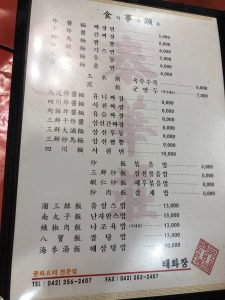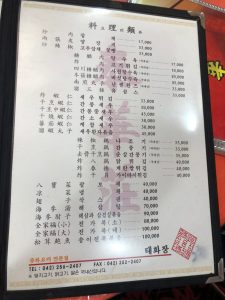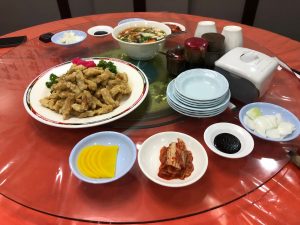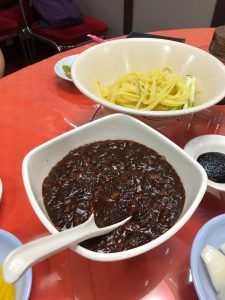For my final project, I had the pleasure of interviewing Mr. Young Chu, the son of the restaurant founder and current restaurant owner of Tae Hwa Jang, located in the city of Daejeon in South Korea. Tae Hwa Jang is a Chinese restaurant and its main dishes are Jja-jiang mian, Jjamppong, and Tangsooyook, and a plethora of traditional Chinese dishes shown in the menu below. Mr. Chu, who came from a family from the Northern regions of China, sells familiar noodle dishes made of wheat, the main crop grown in that area. During the interview, Mr. Chu shared his views on his restaurant’s cultural DNA and how that DNA is expressed in the Chinese noodle dishes; he also did not hesitate to share his personal life story as a Chinese immigrant in Korea back in the 1950’s. I was grateful that he talked about his experiences, as I was able to gain valuable knowledge about the historical survival story of a Chinese restaurant in Korea, and how that influenced Mr. Chu’s life.


Pictures of Tae Hwa Jang Menu (All pictures are self-taken)
Life as a Hwa Gyo in Korea
Mr. Chu is a Hwa Gyo(華僑), meaning he is 100% Chinese who has permanently migrated overseas; in Mr. Chu’s case, Korea. Mr. Chu shared a fair bit about his life as a Hwa Gyo in Korea. He started off with the cultural clashes his family faced when starting a restaurant in a foreign country. Back in the 1950’s, Hwa Gyos couldn’t buy houses or land in Korea. When they went to a broker, they would have had to use a Korean’s name. Mr. Chu talked about how Koreans took advantage of Hwa Gyos easily, since many Hwa Gyos are very isolated and they didn’t have a firm foundational association that could help them. They were mocked often; Hwa gyos were called gullible and stupid, and people had an immense amount of prejudice against them. Although most of it is gone now, still, old people or hobos sometimes come to the restaurant and try to fight with the workers. Mr. Chu said that they tell him to go back to “our land”. “We just normally don’t reciprocate, we’re used to it,” he said with a smile. It only harms them if they go to the police or fight back.
It was very painful to hear this story from someone who must have gone through these horrible experiences for over 50 years. Mr. Chu’s attitude, however, was very understanding. This style of living, Mr. Chu added, was the biggest engine that powered and motivated many Hwa Gyos to succeed in Korea.
How Noodles Influenced Mr. Chu Culturally
The backstory of Mr. Chu was very interesting and valuable because they are real life historical experiences. He elaborated on why the way Hwa Gyos lived in the past had an impact on how noodles influenced himself culturally.
He mentioned that in his life, although being very close in distance to noodle dishes and people who enjoy eating noodle dishes, noodles for him had a different meaning culturally. When the family first started the restaurant, it was very small, with the size of barely 50 cubic meters, and it was very poor. In a state of poverty, noodles were a form of sustenance for Mr. Chu’s family, but in a different way than consumption. It was a source of revenue. As Mr. Chu mentioned before, it was very difficult for the Hwa Gyos to succeed in Korea back in the days. In order to compensate, they worked very diligently night and day to earn money so that they could provide for their family.
During this point in the interview, I asked an additional spontaneous question about the meaning of noodles for Mr. Chu. Usually noodles means a source of joy or that family can get together happily in Chinese culture. I wondered if noodles had ever been as such for him. Mr. Chu answered that when his mindset and goal purpose changed from his youth to adulthood, so did the meaning of noodles. Once a special treat and a joyful meaning, noodles did not mean the same anymore. Now he says he is satisfied by providing that meaning to others because he couldn’t afford to have that experience himself in the past because he was busy working and selling noodles. Mr. Chu said another reason why Hwa Gyos were so motivated to work hard to even neglect the meaning of eating noodles was to go back home. Hwa Gyos believed that once they became prosperous enough in the foreign country, they would have enough money to go back to their homeland indefinitely.
Funnily enough, all that time spent working super hard to go back home rendered Mr. Chu to become very well accommodated to Korea, and now he feels that he can’t go back to his original roots because he is too different. He said that this strongest feeling came from the noodles themselves. The noodles that have been modified to Korean taste buds have become suited to him and he couldn’t eat the Chinese noodles because they are too savory for him.
How Changes in Chinese Society Reflect in Noodle Dishes & Mr. Chu’s Diet
The changing Chinese society, Mr. Chu says, has also influenced his diet and the noodle dishes that he sells. One of the biggest changes is definitely how China had become increasingly prosperous over the years. Back when Mr. Chu’s father came to work in Korea, he did so to earn money and be successful, something he couldn’t imagine doing back where he was from. He took refuge not only from the invasions and colonization of other countries in China, but also China itself: its poverty and stilted business. Hence, Mr. Chu’s father had chosen to sell Jja-jang myun and other expensive Chinese noodle dishes in a big restaurant, in hopes of making lots of money. Although that notion was not the same in Korea, he nonetheless prospered in the growing Korean society by accommodating to it very closely.
Mr. Chu also mentioned his former diet as a kid: potato starch. His family couldn’t afford rice or wheat; instead, they made porridge out of potato starch and ate it as a meal. If they had enough, Mr. Chu and his siblings would attempt to make noodles out of the starch in desire of eating the noodles they couldn’t afford in reality. He says that those days in poverty are probably over for many children in China, due to the continuous prosperity China has had throughout several decades. Noodles that are served in China have been upgraded with the extravagant side dishes that come with them. The society has moved away from eating noodles for sustenance and eating food for health and enjoyment of dining even for low socioeconomic individuals. Mr. Chu said that in his restaurant, there are many individual rooms in which many families reserve for private parties and celebration. Also, accompanied with the noodles are dishes such as shark-fin soup or fried-pork (tang soo yook), indicating a higher standard of living. Additionally, as we learned in class, in many Chinese restaurants can people observe the round tables suited for large families that can eat together while facing every member.

Picture of Round table at Tae Hwa Jang, with side dish Tang Soo Yook
Korean Culture Manifested in Noodle’s DNA
There has been a fair mix of Chinese and Korean cultures in food since the days of countless wars and trades that started thousands of years ago. Through the exchange, culinary parallelism is very much evident in the two nations’ dishes. More recently, around the 1920’s and 50’s, there were a lot of Chinese people who immigrated to Korea like Mr. Chu. Historically, those were the times of the Japense colonization in Eastern Asia and the Korean war, respectively. Many took refuge more and more south, which inevitably introduced a colorful array of foods to Korea. One of the representatives is the Jja-jang mian. Mr. Chu explained that Jja-jang mian in China is yellow. The sauce is not liquidy or sweet and doesn’t use the blackbean sauce but rather a specific fried veggie sauce. After coming to Korea, over the years the noodle dish has been modified to accommodate to the Korean taste buds. It is definitely less savory than the Northern style. It also has a lot more color, the blackness of the Chunjang (blackbean sauce), which is Korea-specific ingredient. More significantly, the cultural DNA of Jja-jang mian has been heavily influenced by the Korean culture. Korea is known for its phrase “Bbali bbali!” which is the same as “kuai dian!”, meaning “quickly quickly!” Koreans have the tendency to want things quickly, get things done quickly, and go places quickly. The dish Jja jiang mian has been molded into the same culture, and since then has been commercialized into a fast food. The development of delivery service is especially prevalent in Korea, and is what greatly materialized the “Bbali bbali” culture. Nowadays, Jja-jang mian is easily ordered over the phone and can be eaten at a piping hot temperature, all within thirty minutes. Most jja-jang myun restaurants can prepare their dishes in less than ten minutes. Thus, instead of being eaten at an elegant round table in at posh restaurant after a twenty minute wait, the dish has now become a convenient alternative that can be gulfed down in front of the TV. It has manifested itself as the go-to delivery food in Korea. Mr Chu mentioned that even Korean restaurants in China that serve jja jang mian offer delivery. The Korean culture has established itself in the noodles even overseas, in the heart of the origin. Jja-jang mian in Korea also has the reputation of its cheap, affordable price. Nonetheless, despite the quickness and the inexpensive price of Jja-jang mian, the noodles still taste very good and do more than justice to its fast delivery and cheapness; and many Koreans never say no to a nice bowl of Jja-jang myun on exhausted days. The traditional Chinese food has accommodated well and made its way to becoming a popular staple in Korea.
Mr. Chu explained that this is very different from the Chinese culture of Jja jiang mian. He couldn’t recall very much, but he always had considered the noodles as a special treat that he only had a few times in his early life; he also remembered eating them at posher restaurants. He also had an opinion that jja-jang mian in China is definitely not as much of a staple food as it is here in Korea. As an owner of a Chinese restaurant in Korea, Mr. Chu has also accommodated his place to the Korean culture. Tae-Hwa Jang, in addition to its grand 2000 cubic meter restaurant full of round tables and individual rooms, also has a delivery service ready for any quick local calls. Mr. Chu explained that in the very beginning when his father founded the restaurant, the delivery service was very poor. He hadn’t known much about it; he was focused more on incorporating the Chinese culture and tastes into the restaurant. However, soon that business grew with the changing Korean society. One can say that the restaurant, founded by Mr. Chu’s father who has experienced first-hand both the noodles of China and Korea, is living history of the noodle exchange that incorporates both the Korean and Chinese cultural DNA.

Picture of Jja jang myun sold in Tae Hwa Jang
The restaurant Tae Hwa Jang together express a very interesting identity for Mr. Chu that arises from his multicultural upbringing in a foriegn country that became home for him. Noodles were a sustenance for Mr. Chu in various ways and its ever-evolving and accommodating nature shaped and molded Mr. Chu to who he is today.
Interview Video Link:
https://youtu.be/CII37UGOs24
Interview Questions:
- What is your name and how would you identify yourself ethnically?
- Where is your hometown? How long have you lived in Korea?
- What made you start a Chinese restaurant in Korea?
- How was it like when you first started the restaurant in Korea? Was there any cultural clashing?
- What kind of noodle dishes do you serve in your restaurant?
- Do you normally make your own dishes(Chinese or Korean) when you eat at home?
- What is the biggest difference between noodles you had as a child and the noodles you are selling in your restaurant?
- What aspects of Chinese culture can you see from your noodles?
- What do you think is the traditional Chinese noodle and what is the cultural significance of noodles in China?
- How have changes in the Chinese society over the years reflected in your noodle dishes?
- How has Korean culture manifested itself in your noodle’s cultural DNA?
- Do you think you can say your noodles are completely Chinese? Why or why not?
- Last Fun Question: What is your favorite Chinese dish?
